哈工大航天学院课程-空间飞行器动力学与控制-第8课-载人飞船技术
- 格式:ppt
- 大小:1.28 MB
- 文档页数:68

Nanjing University of Aeronautics and Astronautics Spacecraft Dynamics and Control Teacher:Han-qing ZhangCollege of AstronauticsSpacecraft Dynamics and Control Text book:Spacecraft Dynamics andControl:A PracticalEngineering Approach/s/1o6BF32U(1) Wertz, J. R. Spacecraft Orbit and Attitude Systems, Springer. 2001(2) 刘墩.空间飞行器动力学,哈尔滨工业大学出版社,2003.(3) 章仁为.卫星轨道姿态动力学与控制,北京航空航天大学出版社,2006.(4) 基于MATLAB/Simulink的系统仿真技术与应用,清华大学出版社,2002。
2014年4月22日星期二Spacecraft Dynamics and ControlSpacecraft Dynamics and Control 1. IntroductionSpace technology is relatively young compared to other modern technologies, such as aircrafttechnology.In only forty years this novel domain hasachieved a tremendous level of complexity andsophistication. The reason for this is simplyexplained: most satellites, once in space, must rely heavily on the quality of their onboardinstrumentation and on the design ingenuity of the scientists and engineers.2014年4月22日星期二Spacecraft Dynamics and ControlSpacecraft Dynamics and Control The desire of humans to conquer space within the solar system will surely encourage newtechnological achievements that are not yetimagined.The technical fields in which satellites are used are numerous一telecommunications, scientificresearch, meteorology, and others.According to the specific task for which they are designed, satellites may be in orbits as low as200 km or as high as 40,000 km above the earth;other spacecraft leave the earth toward planets in the solar system2014年4月22日星期二Spacecraft Dynamics and ControlSpacecraft Dynamics and Control In October 4, 1957, the former Soviet Union sent the world's first artificial satellite into space.In March 11, 1960, the United States launcheda "pioneer" detector,and it was known as thefirst deep-space probe.2014年4月22日星期二Spacecraft Dynamics and Control2014年4月22日星期二Spacecraft Dynamics and ControlSpacecraft Dynamics and ControlIn April 12, 1961,the former SovietUnion successfullylaunched the firstmanned spacecraft. 尤里·加加林Spacecraft Dynamics and ControlIn March 1965, the former Soviet Union realized the first human spacewalk.“上升号”载人飞船2014年4月22日星期二Spacecraft Dynamics and ControlSpacecraft Dynamics and ControlIn January 1966, two spacecrafts completed the rendezvous and docking successfully for the first time in the former Soviet Union .“联盟号”飞船2014年4月22日星期二Spacecraft Dynamics and ControlSpacecraft Dynamics and ControlIn July 1969, the United States landed on the moon for the first time.N.A.阿姆斯特朗E.E.奥尔德林2014年4月22日星期二Spacecraft Dynamics and ControlSpacecraft Dynamics and ControlIn April 19, 1971, the first space station was built successfully with regard to the former Soviet.“和平号”轨道空间站2014年4月22日星期二Spacecraft Dynamics and ControlSpacecraft Dynamics and ControlIn April 1981, the first space shuttle had the successful test flight.“哥伦比亚号”航天飞机首飞记录片2014年4月22日星期二Spacecraft Dynamics and ControlSpacecraft Dynamics and ControlFengYun22014年4月22日星期二Spacecraft Dynamics and ControlSpacecraft Dynamics and Control北斗导航试验卫星定位原理图2014年4月22日星期二Spacecraft Dynamics and ControlSpacecraft Dynamics and Control Satellites may be very heavy: an inhabited space station, for example, could weigh severaltons or more. There also exist very light satellites, weighing 20 kg or less. Small satellites may berelatively cheap.Despite their differences, satellites possess fundamental features that are common to all. The physical laws that govern their motion in spaceand their dynamics are the same for all spacecraft.Hence, the fundamental technologies that evolved from these laws are common to all.2014年4月22日星期二Spacecraft Dynamics and ControlSpacecraft Dynamics and ControlA satellite's life begins with the specificbooster transferring it to some initial orbit,called a transfer orbit, in which the satellite is already circling the earth.For a satellite that will stay near earth, the next stage will be to "ameliorate" theorbit. This means that the satellite must bemaneuvered to reach the precise orbit forwhich the satellite was designed to fulfill its mission.2014年4月22日星期二Spacecraft Dynamics and ControlSpacecraft Dynamics and Control Next, the satellite's software must check for the proper functioning of itsinstrumentation and its performance inspace, as well as calibrate some of theinstruments before they can be used tocontrol the satellite.The final stage is the one for which the satellite was designed and manufactured.2014年4月22日星期二Spacecraft Dynamics and ControlSpacecraft Dynamics and Control Understanding the meaning of each stage will help one to understand the infrastructure of thecontrol system of any satellite.Throughout the text, the terms "satellite" and "spacecraft" (s/c for short) will be usedinterchangeably. The terms "geosynchronous"and "geostationary" will be used interchangeably to describe the orbit of a satellite whose period can be made exactly equal to the time it takes theearth to rotate once about its axis.2014年4月22日星期二Spacecraft Dynamics and ControlSpacecraft Dynamics and ControlA geosynchronous communications satellitewill be described in its different life stages. Acommon, medium-sized satellite is good example.Satellite of this type consist of the following main structural parts.(1) A central body consisting of a cubelikestructure.(2) Solar arrays extended in the N-S direction.(3) An antenna tower directed toward theearth.(4) Controllers(such as reaction thrusters)and attitude sensors(such as sun sensors).2014年4月22日星期二Spacecraft Dynamics and ControlSpacecraft Dynamics and ControlAttitude and orbit control systemThe attitude and orbit control system (AOCS) may include:(1) A reaction bipropellant (反应双组元)thrustsystem.(2) Two momentum wheels (one redundant).2014年4月22日星期二Spacecraft Dynamics and ControlSpacecraft Dynamics and Control(3) Two infrared horizon sensors. (one operating andone redundant)(4) Four fine sun sensors. (two redundant)(5)Twelve coarse sun sensors for safety reasons. (sixredundant)(6)Two three-axis coarse rate gyros(陀螺仪).(7)Two three-axis integrating gyros.2014年4月22日星期二Spacecraft Dynamics and ControlSpacecraft Dynamics and Control Much of the control hardware is redundant in order to guarantee a reliable control systemdespite potential hardware failures.2014年4月22日星期二Spacecraft Dynamics and ControlSpacecraft Dynamics and ControlMission sequenceSequence for injecting a satellite into the geostationary orbit.2014年4月22日星期二Spacecraft Dynamics and ControlSpacecraft Dynamics and ControlFirst is the launch into ageosynchronous transfer orbit(GTO).(地球同步转移轨道)withperigee and apogee (low and highaltitude) of 200 km and 35,786km, respectively.This is followed by the transferfrom GTO to geostationary orbit(GEO)(地球同步静止轨道),whereperigee and apogee both are35,786 km and the orbitinclination and eccentricity areclose to null.2014年4月22日星期二Spacecraft Dynamics and ControlSpacecraft Dynamics and ControlNext is the preparationand calibration of theAOCS.(姿态和轨道控制系统)GEO mission can start,followed by the actualGEO mission stage.2014年4月22日星期二Spacecraft Dynamics and ControlSpacecraft Dynamics and ControlAfter separation from the launcher, the satellite is commanded into a sun acquisition mode with the -X B axis pointing toward the sun. After completion of this stage, the solar panels are partially or fully deployed. If fully deployed, They can be rotated about their axis of rotation toward the sun in order to maximize power absorption.2014年4月22日星期二Spacecraft Dynamics and ControlSpacecraft Dynamics and ControlThe satellite stays in this cruise mode until the first apogee boost motor (ABM) orbit is approached. In the first and the subsequent ABM orbits, several hours before the ABM firing at the apogee, the gyros' calibration maneuvers are initiated.2014年4月22日星期二Spacecraft Dynamics and ControlSpacecraft Dynamics and ControlLess than an hour before any ABM firing, earth acquisition is initiated with the +Z B axis now pointed toward the earth, followed by preparation for the ABM firing stage.2014年4月22日星期二Spacecraft Dynamics and ControlSpacecraft Dynamics and ControlAfter ABM firings ranging from several to more than 30 minutes, the satellite is commanded to GTO cruise. After the last ABM firing, the satellite life is prepared for GEO operation.2014年4月22日星期二Spacecraft Dynamics and ControlSpacecraft Dynamics and ControlIn the first GEO, earth acquisition is performed, meaning that the +Z B axis of the satellite is directed toward the earth center of mass, thus allowing the normal GEO cruise.2014年4月22日星期二Spacecraft Dynamics and ControlSpacecraft Dynamics and ControlThe momentum wheel is spun to its nominal angular velocity to provide momentum bias attitude control. The orbit is then corrected for any remaining inaccuracies in inclination and eccentricity.2014年4月22日星期二Spacecraft Dynamics and ControlSpacecraft Dynamics and ControlThe satellite orbit dynamics and controlThe classical equations of motion of ideal Keplerian orbits.The basic orbital control concepts including control and station keeping of satellites.The attitude dynamics and controlThe basic equations of rotational motion about some axis through its center of mass.Single-and Dual-spin stabilization.The attitude stabilization and maneuvering ofspacecraft stabilized in three axes.2014年4月22日星期二Spacecraft Dynamics and Control。
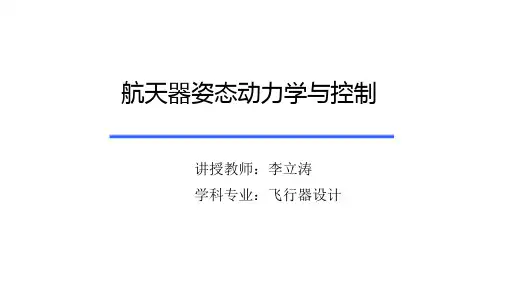

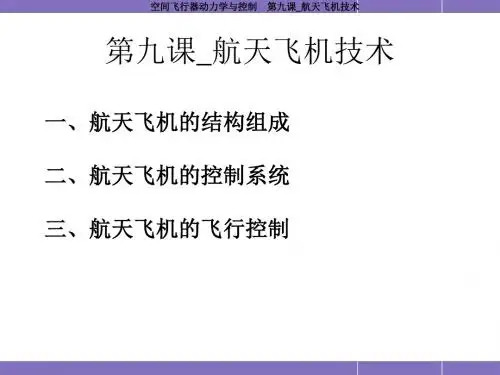
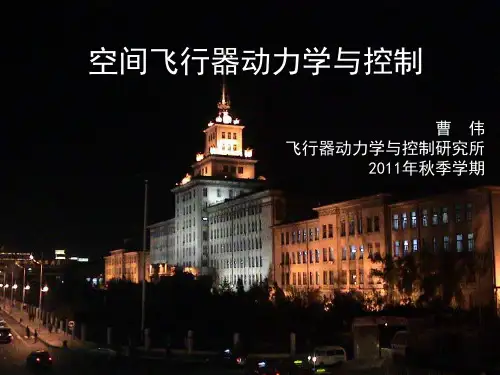

航天飞行动力学是研究航天器和运载器在飞行中所受的力及其在力作用下的运动的学科,也称为航天器动力学。
它是建立航天器设计、发射和运行控制的重要基础。
航天飞行动力学的研究内容包括航天器的轨道运动、姿态运动以及推力控制等。
其中,轨道运动是指航天器在地球或其他天体周围绕行运动的规律,包括圆轨道、椭圆轨道、抛物线轨道等;姿态运动是指航天器绕自身轴线旋转或摆动的运动,包括自旋稳定、三轴稳定等。
推力控制是指通过施加推力来改变航天器的运动状态,包括轨道机动、姿态控制等。
航天飞行动力学的研究目的是为航天器的设计、发射和运行控制提供理论支持,确保航天器的安全、可靠和经济性。
在实际应用中,航天飞行动力学也是制定发射窗口、规划轨道转移、进行精确导航定位等的重要依据。
以上内容仅供参考,如需更多信息,建议查阅相关文献或咨询相关学者。
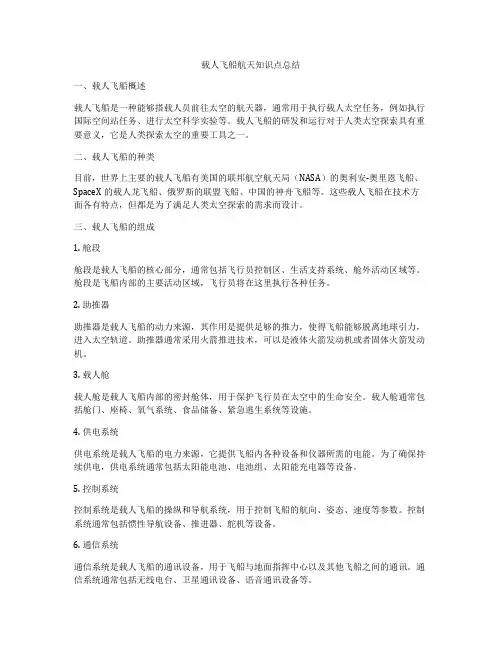
载人飞船航天知识点总结一、载人飞船概述载人飞船是一种能够搭载人员前往太空的航天器,通常用于执行载人太空任务,例如执行国际空间站任务、进行太空科学实验等。
载人飞船的研发和运行对于人类太空探索具有重要意义,它是人类探索太空的重要工具之一。
二、载人飞船的种类目前,世界上主要的载人飞船有美国的联邦航空航天局(NASA)的奥利安-奥里恩飞船、SpaceX的载人龙飞船、俄罗斯的联盟飞船、中国的神舟飞船等。
这些载人飞船在技术方面各有特点,但都是为了满足人类太空探索的需求而设计。
三、载人飞船的组成1. 舱段舱段是载人飞船的核心部分,通常包括飞行员控制区、生活支持系统、舱外活动区域等。
舱段是飞船内部的主要活动区域,飞行员将在这里执行各种任务。
2. 助推器助推器是载人飞船的动力来源,其作用是提供足够的推力,使得飞船能够脱离地球引力,进入太空轨道。
助推器通常采用火箭推进技术,可以是液体火箭发动机或者固体火箭发动机。
3. 载人舱载人舱是载人飞船内部的密封舱体,用于保护飞行员在太空中的生命安全。
载人舱通常包括舱门、座椅、氧气系统、食品储备、紧急逃生系统等设施。
4. 供电系统供电系统是载人飞船的电力来源,它提供飞船内各种设备和仪器所需的电能。
为了确保持续供电,供电系统通常包括太阳能电池、电池组、太阳能充电器等设备。
5. 控制系统控制系统是载人飞船的操纵和导航系统,用于控制飞船的航向、姿态、速度等参数。
控制系统通常包括惯性导航设备、推进器、舵机等设备。
6. 通信系统通信系统是载人飞船的通讯设备,用于飞船与地面指挥中心以及其他飞船之间的通讯。
通信系统通常包括无线电台、卫星通讯设备、语音通讯设备等。
7. 生命支持系统生命支持系统是载人飞船内部的气体、水和食品供应系统,用于维持飞行员在太空中的生存所需。
生命支持系统通常包括空气净化设备、水循环系统、食品储备等设施。
四、载人飞船的发射与返回1. 预发射准备在载人飞船发射前,需要进行一系列的预发射准备工作,包括检查飞船各个系统的运行状态、确定发射时间、进行直觉和气象条件的评估等。
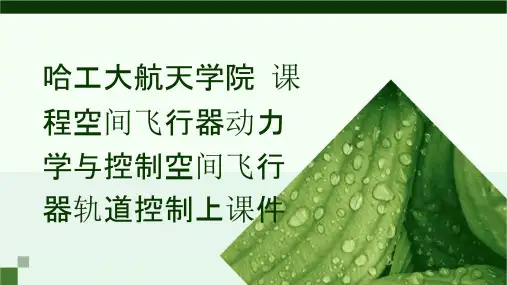
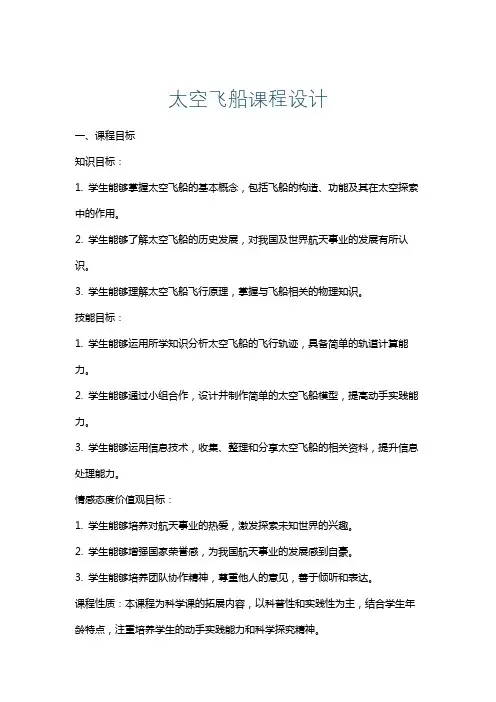
太空飞船课程设计一、课程目标知识目标:1. 学生能够掌握太空飞船的基本概念,包括飞船的构造、功能及其在太空探索中的作用。
2. 学生能够了解太空飞船的历史发展,对我国及世界航天事业的发展有所认识。
3. 学生能够理解太空飞船飞行原理,掌握与飞船相关的物理知识。
技能目标:1. 学生能够运用所学知识分析太空飞船的飞行轨迹,具备简单的轨道计算能力。
2. 学生能够通过小组合作,设计并制作简单的太空飞船模型,提高动手实践能力。
3. 学生能够运用信息技术,收集、整理和分享太空飞船的相关资料,提升信息处理能力。
情感态度价值观目标:1. 学生能够培养对航天事业的热爱,激发探索未知世界的兴趣。
2. 学生能够增强国家荣誉感,为我国航天事业的发展感到自豪。
3. 学生能够培养团队协作精神,尊重他人的意见,善于倾听和表达。
课程性质:本课程为科学课的拓展内容,以科普性和实践性为主,结合学生年龄特点,注重培养学生的动手实践能力和科学探究精神。
学生特点:六年级学生具备一定的科学知识基础,好奇心强,善于观察和思考,但注意力容易分散,需要通过有趣的教学活动来保持学习兴趣。
教学要求:教师应采用多元化的教学手段,如讲授、讨论、实验、小组合作等,引导学生主动参与,确保课程目标的达成。
同时,注重过程性评价,关注学生的学习成果和情感体验。
二、教学内容1. 太空飞船基本概念:包括飞船的构造、分类、功能及其在太空探索中的应用。
教材章节:第五章“航天器与太空探索”2. 太空飞船发展历史:介绍世界航天发展历程,重点掌握我国航天事业的重要里程碑。
教材章节:第五章“航天器与太空探索”第三节“航天发展简史”3. 飞船飞行原理:学习万有引力、牛顿运动定律等与飞船飞行相关的物理知识。
教材章节:第四章“力和运动”第二节“牛顿运动定律”4. 太空飞船轨道计算:了解轨道基本概念,学习简单的轨道计算方法。
教材章节:第五章“航天器与太空探索”第四节“航天器轨道”5. 太空飞船模型设计与制作:分组进行模型设计与制作,培养动手实践能力。
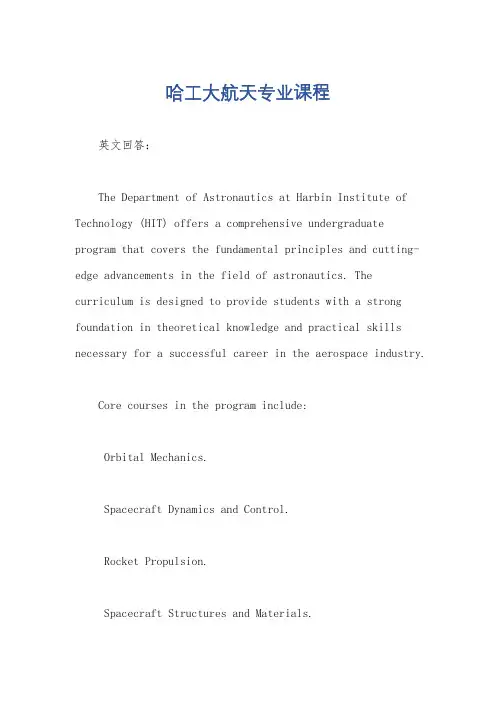
哈工大航天专业课程英文回答:The Department of Astronautics at Harbin Institute of Technology (HIT) offers a comprehensive undergraduate program that covers the fundamental principles and cutting-edge advancements in the field of astronautics. The curriculum is designed to provide students with a strong foundation in theoretical knowledge and practical skills necessary for a successful career in the aerospace industry.Core courses in the program include:Orbital Mechanics.Spacecraft Dynamics and Control.Rocket Propulsion.Spacecraft Structures and Materials.Spacecraft Electromagnetic Compatibility.Spacecraft Thermal Control.Spacecraft Communication.Spacecraft Navigation.Students also have the opportunity to specialize in areas such as:Spacecraft Design.Spacecraft Systems Engineering.Spacecraft Guidance, Navigation, and Control.Spacecraft Propulsion.Spacecraft Structures and Materials.The program emphasizes hands-on experience through laboratory work and research projects. Students have access to state-of-the-art facilities, including:Spacecraft Simulation Laboratory.Spacecraft Propulsion Laboratory.Spacecraft Structures Laboratory.Spacecraft Electromagnetic Compatibility Laboratory.Spacecraft Thermal Control Laboratory.The Department of Astronautics at HIT has a strong faculty of renowned experts in the field of astronautics. Faculty members are actively involved in research and development in areas such as spacecraft design, spacecraft systems engineering, spacecraft guidance, navigation, and control, spacecraft propulsion, and spacecraft structures and materials.Graduates of the program are well-prepared for careers in the aerospace industry, government agencies, and research institutions. They are highly sought after by leading companies such as China Aerospace Science and Technology Corporation (CASC), China Academy of Space Technology (CAST), and China National Space Administration (CNSA).中文回答:哈工大航天专业课程。
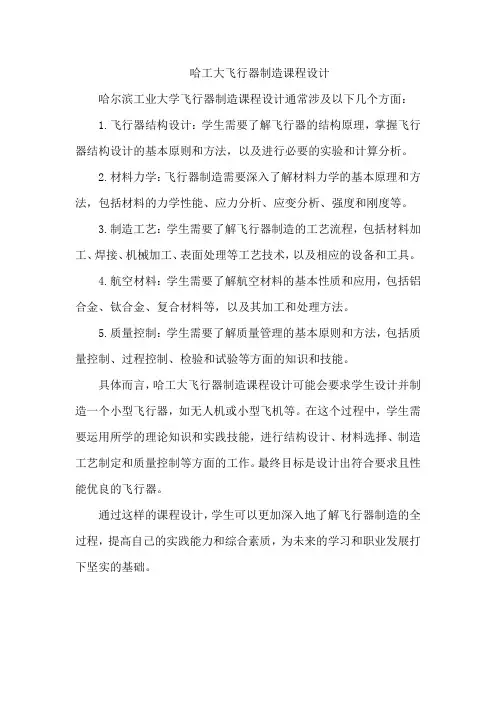
哈工大飞行器制造课程设计
哈尔滨工业大学飞行器制造课程设计通常涉及以下几个方面:
1.飞行器结构设计:学生需要了解飞行器的结构原理,掌握飞行器结构设计的基本原则和方法,以及进行必要的实验和计算分析。
2.材料力学:飞行器制造需要深入了解材料力学的基本原理和方法,包括材料的力学性能、应力分析、应变分析、强度和刚度等。
3.制造工艺:学生需要了解飞行器制造的工艺流程,包括材料加工、焊接、机械加工、表面处理等工艺技术,以及相应的设备和工具。
4.航空材料:学生需要了解航空材料的基本性质和应用,包括铝合金、钛合金、复合材料等,以及其加工和处理方法。
5.质量控制:学生需要了解质量管理的基本原则和方法,包括质量控制、过程控制、检验和试验等方面的知识和技能。
具体而言,哈工大飞行器制造课程设计可能会要求学生设计并制造一个小型飞行器,如无人机或小型飞机等。
在这个过程中,学生需要运用所学的理论知识和实践技能,进行结构设计、材料选择、制造工艺制定和质量控制等方面的工作。
最终目标是设计出符合要求且性能优良的飞行器。
通过这样的课程设计,学生可以更加深入地了解飞行器制造的全过程,提高自己的实践能力和综合素质,为未来的学习和职业发展打下坚实的基础。
《空间飞行器飞行动力学》课程教学大纲课程编码: T1180230课程中文名称:空间飞行器飞行动力学课程英文名称:SPACECRAFT DYNAMICS总学时:50 讲课学时:50 实验学时:0习题学时:0 上机学时:0学分:3授课对象:飞行器设计专业、空间环境专业本科生先修课程:高等数学、普通物理、理论力学、自动控制理论教材及参考书:《空间飞行器动力学》,刘暾. 赵钧,哈尔滨工业大学出版社《空间飞行器动力学与控制》,M.H.卡普兰一、课程教学目的《空间飞行器动力学》是一门航天工程专业学生的专业基础课。
本课程主要研究空间飞行器动力学的基本概念、原理和应用,包括轨道动力学和姿态动力学两大部分,其主要任务是培养学生:建立空间飞行器动力学的基本概念,理解飞行器的运动与受力之间的关系,掌握空间飞行器动力学问题的基本分析方法;掌握应用空间飞行器动力学的基本理论,解决一般的空间飞行器动力学应用问题的基本技能;了解空间飞行器动力学理论、方法及其应用的最新发展;掌握使用相关的参考文献、计算机应用软件进行动力学问题研究分析的能力;《空间飞行器动力学》是高等工科院校中航天工程类专业的一门主要课程。
通过该课程的学习,学生可以初步掌握解决空间飞行器动力学问题的基本方法和技能,并了解其他空间飞行器应用问题的动力学依据,为日后从事空间飞行器的动力学及其他的空间飞行器应用专业的研究工作奠定初步的理论基础。
二、教学内容及基本要求轨道动力学部分(上篇)第一章绪论(1学时)概论,齐奥尔科夫斯基公式,单级火箭的极限速度。
第二章空间飞行器的入轨(1学时)运载火箭的运动方程式,纵向平面内的动力学方程,运载火箭导引规律。
第三章空间飞行器的轨道(4学时)两体运动方程的建立、求解,中心引力场中的运动,四种基本轨道的轨道方程、特性及时间方程。
第四章轨道的建立和星下点轨迹(2学时)空间飞行器轨道建立的方法,轨道要素与发射参数的关系,星下点轨迹的描述。